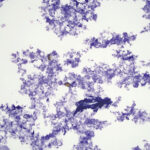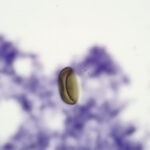Aspirate from the gall bladder of a cat
Case Information
An 11-year-old female spayed domestic shorthair cat was presented with a 3-4 week history of progressive weight loss. The cat was obtained as a kitten from the island of St John and then had lived on a farm in Massachusetts until 8 years of age. The cat had been solely an indoor cat for the prior 3 years with the current owner.
On examination, the cat was quiet, alert, and responsive, but febrile (102ºF) and tachycardic (200 beats per minute), with slight tachypnea (32 breaths per minute). The rest of the physical examination was within normal limits. Clinical pathology testing revealed normal hemogram results with several abnormalities in a biochemical panel, including hyperglycemia (298 mg/dL, reference interval [RI], 71-182 mg/dL), increased alanine aminotransferase (ALT) (432 U/L, RI, 28-109 U/L), alkaline phosphatase (ALP) (424 U/L, RI, 11-49 U/L), γ-glutamyl transferase (GGT) (10 U/L, RI, 0-2 U/L) activities, and increased total bilirubin concentration (1.6 mg/dL, RI, 0-0.2 mg/dL). Urine dipstick analysis revealed a 2+ reaction for glucose, 3+ reaction for ketones, and 2+ reaction for bilirubin. Abdominal ultrasonography revealed a mildly enlarged liver that was moderately hyperechoic, a full gall bladder with anechoic bile, and a dilated common bile duct. The liver and gall bladder were aspirated and submitted for cytologic evaluation. View the representative photomicrographs of the direct smear of the aspirated bile and answer the questions below.
- Based on the provided imaging findings and biochemical results, what disease process(es) is/are occurring in the liver, i.e. what do you expect to see in the liver aspirate?
- Can you think of a contributing cause?
- What biochemical result is unexpected for the suspected pathologic process involving the liver?
- What is your cytologic diagnosis from the bile?
- Do the findings in the bile explain the changes in the biochemical panel?
Answers on next page


